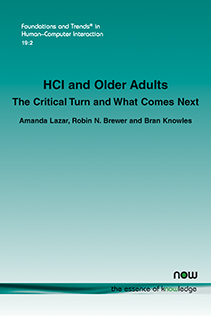HCI and Older Adults: The Critical Turn and What Comes Next
By Amanda Lazar, University of Maryland, USA, lazar@umd.edu | Robin N. Brewer, University of Michigan, USA, rnbrew@umich.edu | Bran Knowles, Lancaster University, UK, b.h.knowles1@lancaster.ac.uk
Abstract
Human-Computer Interaction (HCI) has long studied the design of technology for older adults. A critical turn problematizing how older adults were being framed gained momentum in the 2010s. The literature comprising this critical turn offered insights for what researchers should avoid in their work as well as high level future directions. Past work was critiqued for positioning older adults as incapable technology users, the same as one another, and chronically ill and in need of care. In this monograph, we summarize some of the research that followed and responded to the critiques that began this critical turn. We focus our review on three spaces: technology use, intersectionality, and care. We describe how researchers have fruitfully drawn upon other disciplines including feminist and critical studies, gerontology, social computing, and disability studies to further break down myths, generate knowledge, and open new research spaces. We include our view of the gaps that remain and what should come next.
HCI and Older Adults: The Critical Turn and What Comes Next
Human-Computer Interaction (HCI) has long studied the design of technology for older adults. The community of HCI researchers working with older adults was no exception to facing a convergence of critique. While there had been critiques made prior, a number of arguments emerged around the same time arguing the broad ways in which existing research had problematic foundations. This included writing and talking about older adults as if they were a homogenous group, a strong emphasis on deficit and decline, and stereotyping views when it came to technology use. The critical turn problematizing how older adults were being framed gained momentum in the 2010s. The literature comprising this critical turn offered insights for what researchers should avoid in their work, as well as high level future directions. Past work was critiqued for positioning older adults as incapable technology users, the same as one another, and chronically ill and in need of care. This monograph summarizes the research that followed and responded to the critiques that began this critical turn.
This monograph is focused on three spaces: technology use, intersectionality, and care. The work describes how researchers have fruitfully drawn upon other disciplines including feminist and critical studies, gerontology, social computing, and disability studies to further break down myths, generate knowledge, and open new research spaces. Also included is a view of the gaps that remain and what should come next.
